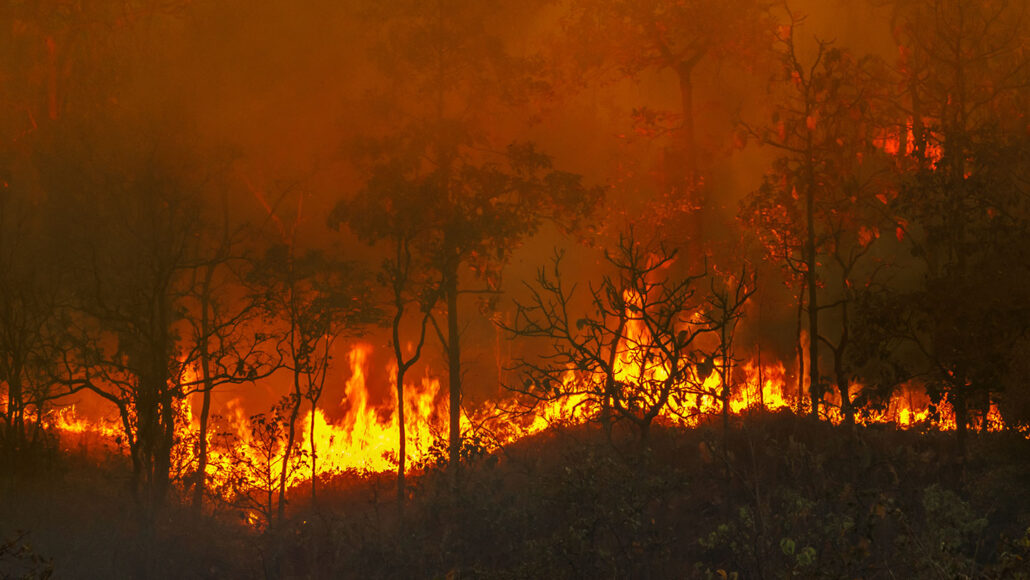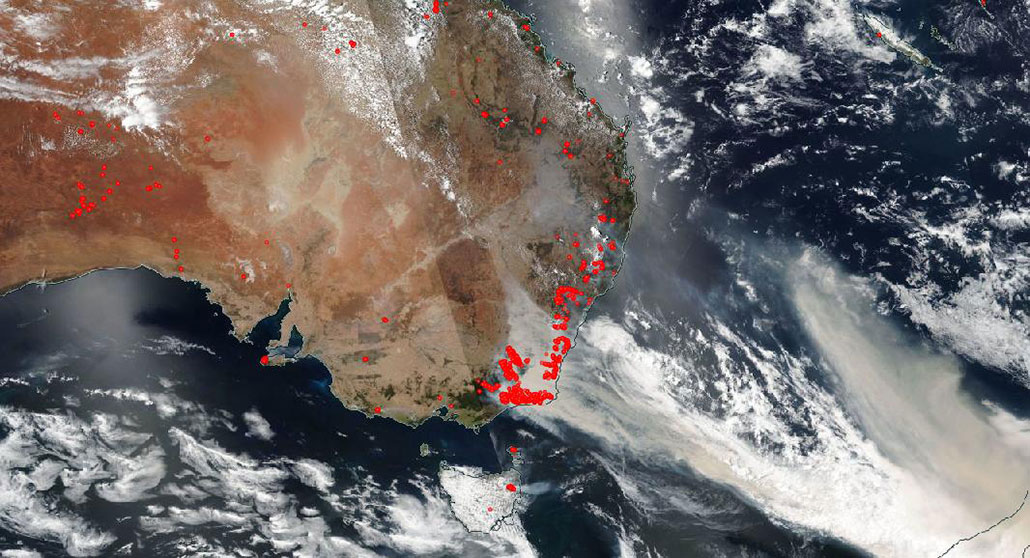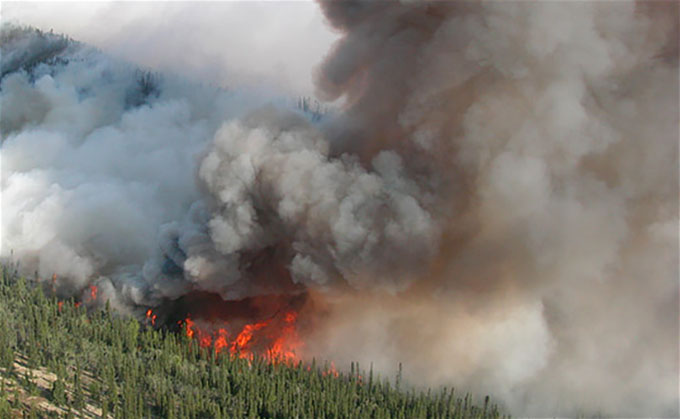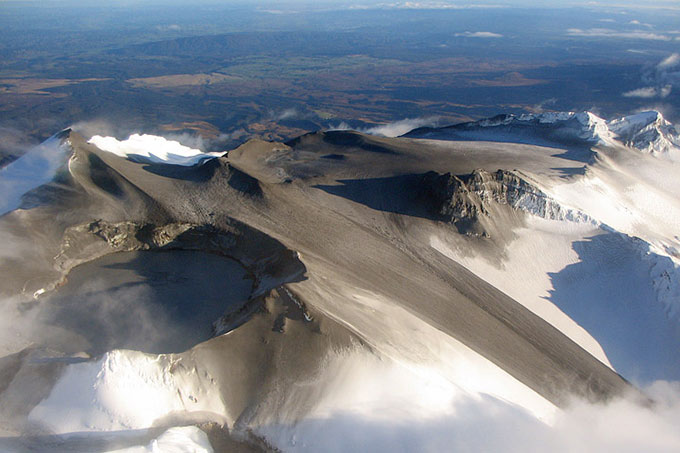Can wildfires cool the climate?
Tiny airborne particles, like those spewed by forest fires, can alter Earth’s temperature

Wildland fires generate intense heat. But plumes of the sooty smoke that they emit can rise to high altitudes. There it can block out much of the sun’s light, causing a ground-level cooling.
Toa55/iStock/Getty Photos
Wildfires have captured headlines around the globe in recent years. In 2018, California wildfires caused record destruction and death. But the area they incinerated would be eclipsed by fires in 2020. Some of those fires roared out of control for weeks in a swath that spanned the U.S. West Coast, from Canada down to Mexico. And a surprise 2020 outbreak of wildfires across the Siberian Arctic incinerated grasslands and tundra.
These intense and widespread fires worry scientists. And for many reasons. Besides causing billions of dollars in property damage, they can erase the habitat of valued wildlife. They also fill the air with choking pollution. And when they burn near cities, they put the lives of whole communities in danger. The November 2018 Camp Fire was the deadliest in California history. Within days it wiped out 18,800 buildings, including much of Paradise, Calif. Some infernos even burn so hot that they can spawn firenadoes.
But scientists are interested in these fires for yet another reason. The black carbon-rich smoke billowing from their flames is made of the soot and ash from burned trees, grass and shrubs. The intense heat of some infernos can propel this soot and ash to altitudes so high that it can circumnavigate the globe. And the warming sunlight absorbed by dark particles at high altitudes won’t reach Earth’s surface.
Scientists refer to those tiny airborne particles of soot, dust and more as aerosols (AIR-oh-sahls). One important trait is how well they reflect light. Albedo is the term for this. Snow and white ice have a high albedo; they reflect the most light. Tar and asphalt have a low albedo, absorbing the sun’s light, mostly as heat. So the color of aerosols is important.
Whether we’re aware of them or not, aerosols are everywhere. And they can play a major role in where sunlight has its greatest impact on Earth’s temperature.
The climate trend toward big wildfires
Many studies show that intense wildfires are becoming more common. In part, that’s because of global warming. Geert Jan van Oldenborgh led one of these studies. He studies extreme weather at the Royal Netherlands Meteorological Institute in De Bilt.
It’s hard to be absolutely sure which extreme events are due to a changing climate. But scientists have developed a field of research — attribution science — to do that. It attempts to gauge how likely it was that an event would have occurred if the climate hadn’t been warming as it has. Van Oldenborgh led one attribution study of the Australian fires in 2019 and 2020.
“The Australian bushfires were caused by extreme weather,” he says. “So we investigated how much more extreme this ‘fire weather’ has become due to global warming.”

And global warming made these intense fires at least 30 percent more likely, they found. “There was a strong trend toward more extreme heat in the region where the bushfires raged,” he reports. Climate models also point to the world getting warmer overall. “The kind of weather that leads to these bushfires will become more and more common,” he says.
The Western United States got a taste of that in 2020. In California alone, the year saw more than 9,600 wildfires. Together they torched almost 1.7 million hectares (4.2 million acres) of land. A dry storm ignited one especially intense woodland inferno. Before it was extinguished, it had scorched 526,000 hectares (1.3 million acres). Extremely dry soils and brush left the area especially vulnerable.
While 2020 was a record year for California wildfires, the U.S. trend toward frequent, intense fires is hardly new. Every year in this country for the past decade, an average of 64,100 wildfires have ignited. They’ve been burning through an average of 2.8 million hectares (6.8 million acres) annually, according to a December 4, 2020 report by the Congressional Research Service.
Indeed, California has been especially hard hit. And a new study shows why. Since 1980, it found, average temperatures across the state have risen about 1 degree Celsius (1.8 degrees Fahrenheit). At the same time, rain and snowfall totals have dropped by almost one-third. This has left huge swaths throughout the state very, very dry. This steadily warming climate didn’t cause the state’s fires. However, it set the stage for them, the new study found. This heat also exaggerated the impacts once flames ignited. Michael Goss of Stanford University in California and his colleagues described their analysis in the August 20, 2020 Environmental Research Letters.

Modeling wild, wild fires
Effects on the ground can become white hot as fires burn through wildlands. But one result of those fires may be a temporary and localized cooling of the climate that spawned them. That’s the conclusion of an international team of researchers.
Yiquan Jiang works at Nanjing University in China. This atmospheric scientist is part of a group that recently looked into how the aerosols spewed by forest fires affect Earth’s temperatures. They turned to a type of computer program known as a climate model.
It uses math to describe the processes that drive Earth’s climate. Then scientists vary one or more features in the model. Perhaps it’s the dryness of the surface brush. Or it might also be the size of aerosols, their albedo or how high they rise into the air. Then scientists runs the model to predict whether, where and for how long a fire’s smoke might warm or cool the atmosphere.
Such computer models are a great way for scientists to test a theory. As they change one feature of the smoke, weather or ground terrain at the time of the fire, they can see how another feature may change. In this study, Jiang’s group changed the amount of forest fire aerosols. Then they watched how Earth’s temperature changed.

Those aerosols can either warm or cool the air. The dark color of fire aerosols near Earth’s surface can result in more heat being absorbed. Overall, however, the model by Jiang’s team showed that smoke aerosols cool the atmospheric. As intense fires propel dark, sooty aerosols high into the air, they mix with clouds and mostly shield the sun’s energy.
“The effect due to cooling,” Jiang explains, “is much larger than [any fire-related atmospheric] warming.” Averaged over the whole world, the smoke aerosols cause between 50 and 300 percent more cooling than they do warming.
The researchers described their findings on April 15, 2020, in the Journal of Climate.
The strength of the climate-altering effect of those fire aerosols will vary by region, Jiang reports. “For tropical fires, like in Australia or the Amazon, the fire aerosols could induce drought,” he explained. However, he notes, where fires burn vast regions outside the tropics, such as in Alaska or Siberia, “the cooling effect could be dominant.”
There remains uncertainty about how well a computer can mimic the real world. The programs cannot capture every little detail. Indeed, Jiang admits, the programs need to improve how well they model the way fire aerosols interact with clouds. However, the results of his team’s model do agree well with observations of aerosols spewed by real fires. This is encouraging, he says. It “helps ensure the reliability of our results.”
But fire aerosols also can have quite different effects when they fall back to Earth. And that fallout can sometimes be up to half a world away from where a fire took place. That’s the finding of another new study.`
It found that smoke released over India rose high in the air and condensed into aerosols of soot and tar. These wafted east into the Himalayas in China and Tibet. There they fell to the ground, darkening snow and ice. Those dark aerosols then absorbed the sun’s heat. And this led to the melting of high altitude glaciers.
Weijun Li is an atmospheric scientist at Zhejiang University in Hangzhou, China. He and his team reported those findings November 4, 2020 in Environmental Science & Technology Letters.

So, fire aerosols have a mixed effect. They can cool the atmosphere at high altitudes, or warm the air — and even melt ice — at Earth’s surface. This dual effect is why no one would suggest that fires are a good way to compensate for global warming. In fact, scientists like Jiang note, any cooling probably takes place only in the region where the fires occur, not widely across the globe.
Van Oldenborgh in the Netherlands agrees. He emphasizes that a wildfire’s impacts and risks will largely occur on a regional level. “For instance,” he points out, “in Sweden and Siberia, we found there will also be an increase in rain during the summer.” That could lessen the impacts of the increase in temperature. “In California,” he points out, “other researchers found that summer forest fires are affected by climate change. But forest fires in spring are not.” He also thinks the regional impacts of fires won’t do much to slow global warming. “The amount of aerosols from these fires is still too small to have more than a local, short-lived effect.”
It’s just a weird irony that the warming climate that can foster wildfires may undergo a temporary cooling when catastrophic wildfires do erupt. As the planet warms and new fires flare up, scientists will continue to explore the big impact of tiny fire aerosols that temporarily occupy our atmosphere.







